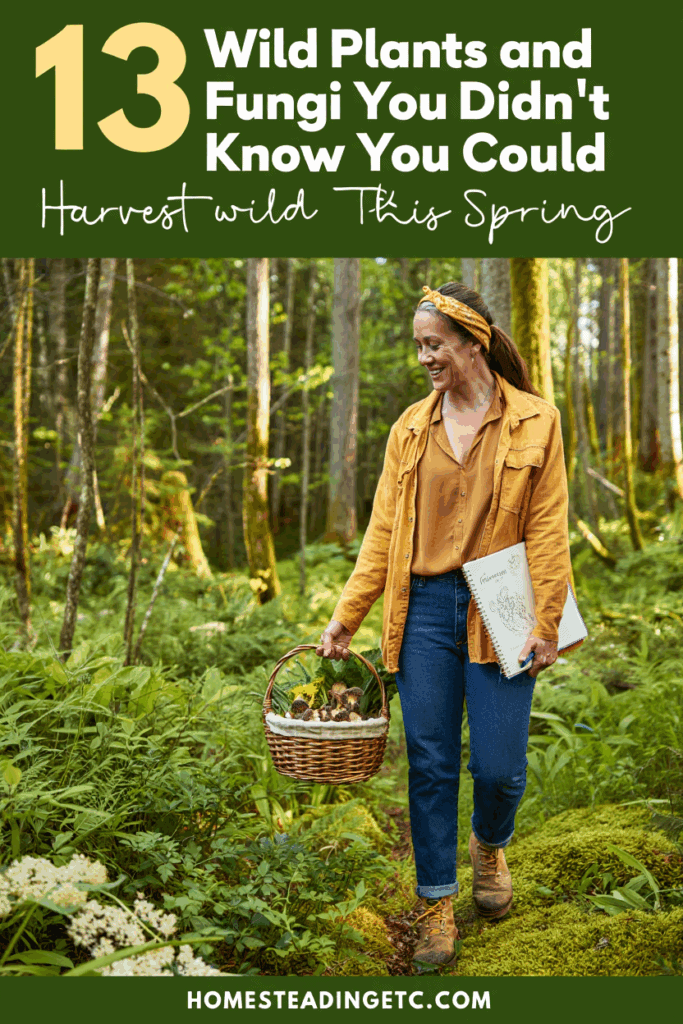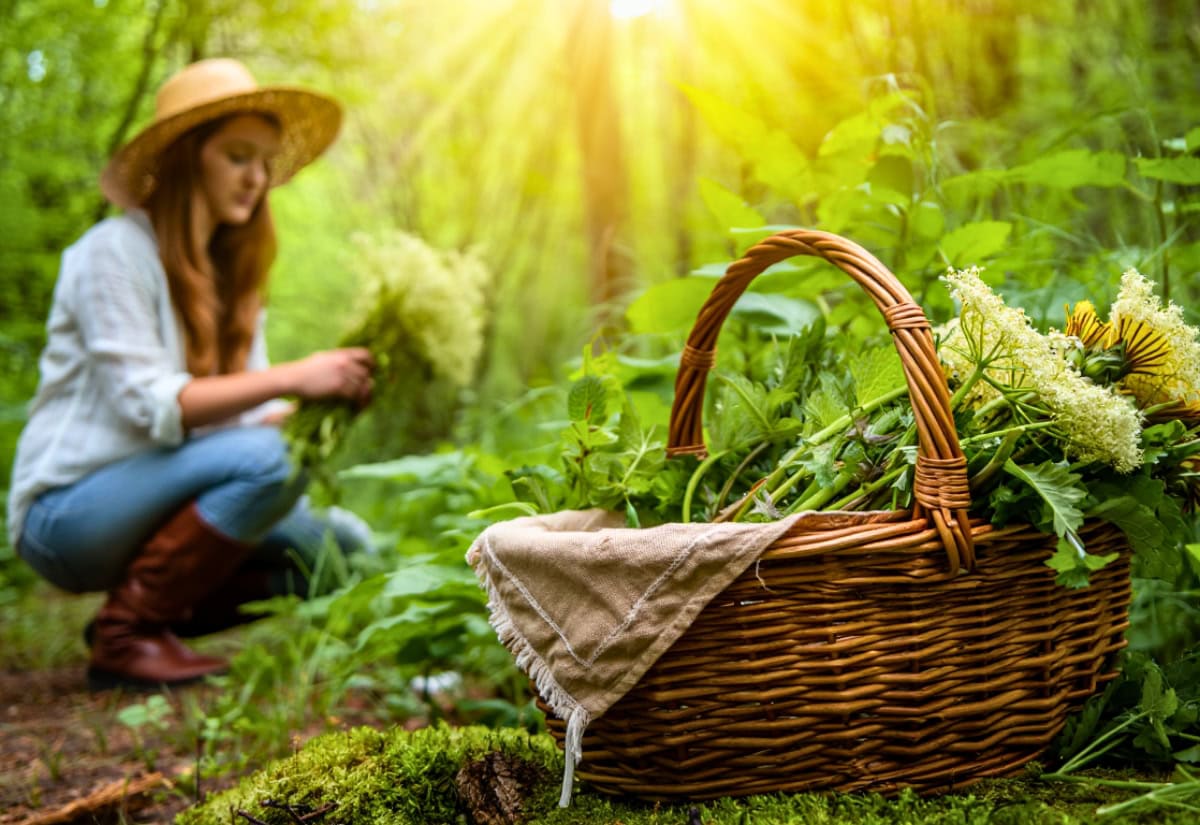Did you know your next superfood or herbal remedy could be growing wild right now?
Spring is the perfect time to step outside and discover a treasure trove of edible and medicinal plants and fungi. As the earth wakes up from its winter slumber, vibrant greens and earthy mushrooms emerge—offering more than just beauty. They hold incredible health benefits and fresh, unique flavors that can transform your meals and well-being.
Foraging in spring is not only about finding food—it’s about connecting deeply with nature, fostering sustainable living, and appreciating the diversity of wild species that nourish and heal. Each plant you gather tells a story and strengthens your bond with the environment.
⚠️ Caution: Not all wild plants and fungi are safe. Many have toxic lookalikes. Carry a trusted field guide, learn to identify species carefully, and always forage responsibly. The rewards are endless when done safely.

Foraging Basics: Respect the Wild, Reap the Rewards
Foraging isn’t about grabbing everything you see; it’s a mindful practice. When you step into a forest or field, think of yourself as a guest. Take only what you need, leave plenty behind, and never harvest rare or protected species.
- Know the rules: Some parks restrict foraging. Check local regulations.
- Harvest responsibly: Leave enough plants to regrow and support local wildlife.
- Leave no trace: Stick to trails, avoid trampling habitats, and clean up after yourself.
This respect ensures future foragers—and nature itself—continue to thrive.
Stay Safe While You Forage
Foraging is thrilling, but misidentification can have serious consequences. Here are a few rules every forager should live by:
- Avoid polluted areas: Skip roadside plants—they may absorb toxins.
- Learn your plants: Use a trusted field guide or app. Some edible plants have toxic lookalikes.
- Test cautiously: If it’s new to you, try only a small amount at first.
- Gear up: Wear sturdy shoes, gloves, and carry a basket or breathable bag.
- Respect wildlife: Many insects, birds, and animals depend on these plants, too.
Edible Plants to Forage in Spring
With the coming of spring, nature offers a bounty of fresh, edible plants just waiting to be discovered. Foraging during this season is not only a delightful way to reconnect with the environment but also a fantastic opportunity to add some natural flavors and nutrients to your diet. Let’s explore some of the most intriguing edible plants you might encounter.
1. Wild Garlic (Allium vineale / Allium ursinum)

Imagine wandering through a damp woodland and catching the sharp scent of garlic in the air—that’s your first sign of wild garlic. Its long, narrow leaves resemble scallions but grow in clusters, often carpeting shady forest floors. By late spring, delicate white flowers appear, making it even easier to spot.
This plant is entirely edible:
- The leaves are aromatic and perfect for salads or as a garnish.
- The bulbs can substitute for regular garlic in cooking.
- Even the flowers add a mild flavor to dishes.
Wild garlic is not only a culinary delight but also rich in antioxidants and compounds that may support heart health. Use it to make vibrant pesto, stir into creamy soups, or sprinkle over roasted vegetables. It’s a seasonal gem that captures spring in every bite.
2. Dandelion (Taraxacum officinale)

Often dismissed as a weed, dandelion is actually one of the most versatile wild plants. Its bright yellow flowers open to the sun, while jagged leaves form a basal rosette close to the ground. Every part of this plant is usable and beneficial.
- Leaves: Best harvested young, they are nutrient-packed and slightly bitter, great in salads or sautéed.
- Flowers: Sweet and mild, perfect for making dandelion wine or adding to fritters.
- Roots: When roasted, they make a coffee-like drink with detoxifying benefits.
Dandelions are loaded with vitamins A, C, and K and minerals like iron and calcium. Traditionally, they’ve been used for liver health and digestion. Foragers love them because they’re abundant, easy to identify, and a true superfood hiding in plain sight.
3. Stinging Nettles (Urtica dioica)

Nettles may seem unwelcoming with their stinging hairs, but they reward anyone willing to handle them properly. Their tall stalks and serrated, heart-shaped leaves grow in clusters near moist, nutrient-rich soil.
Boiling or steaming removes the sting, revealing a deep green that tastes earthy, similar to spinach but with more character.
- Uses: Add to soups, stews, or blend into smoothies. They can also be dried for tea.
- Benefits: High in iron, protein, calcium, and anti-inflammatory compounds.
Historically, nettles have been used to treat anemia and joint pain. Modern foragers value them for their nutrition and flavor, making them a springtime staple.
4. Lamb’s Quarters (Chenopodium album)

Known as wild spinach, lamb’s quarters grow freely in disturbed soils and gardens. The plant has soft, diamond-shaped leaves with a powdery coating underneath, giving it a silvery look in sunlight.
Its flavor is mild, and it’s incredibly versatile:
- Cooking: Use like spinach in sautés, soups, or fillings.
- Nutritional Value: Contains protein, fiber, calcium, and a wide range of vitamins.
Once a traditional food of many cultures, this plant remains a wild green worth rediscovering. Foragers often rank it alongside cultivated spinach for taste and nutrition.
5. Purslane (Portulaca oleracea)

Purslane spreads low to the ground, with reddish stems and succulent, paddle-shaped leaves that store moisture. Its taste is slightly sour with a refreshing crunch, making it perfect for summer salads.
- Culinary Uses: Eat raw in salads, add to soups, or mix into stir-fries for extra texture.
- Health Benefits: One of the best plant sources of omega-3 fatty acids, supporting heart and brain health.
In many cultures, purslane is considered a valuable edible. Its combination of taste, texture, and nutrition makes it a star among wild greens.
🌿 Each of these wild edibles offers a chance to savor spring in its purest form.
Medicinal Plants to Forage in Spring
Beyond the kitchen, spring plants also bring powerful healing properties. For centuries, herbalists have used these species to soothe, strengthen, and rejuvenate.
6. Chamomile (Matricaria chamomilla)

Chamomile’s small, daisy-like flowers hold calming magic. Often found in sunny meadows, its gentle fragrance has soothed people for generations. It’s best known for reducing anxiety and aiding sleep, but it also eases stomach discomfort.
To make tea:
- Gather fresh flowers.
- Dry them on a towel in a shaded place.
- Steep 1–2 tsp in hot water for 5 minutes.
This cup of floral warmth relaxes the body and comforts the soul—an herbal hug in every sip.
7. Plantain (Plantago major)

Plantain, not the banana, is a broad-leaved plant that thrives in lawns and paths. Known as the “Band-Aid Plant”, it works wonders on minor wounds, insect bites, and rashes.
- Topical Use: Crush leaves to release soothing juices and apply directly to skin.
- Infusion: Steep in hot water to create a wash for irritations.
Foragers prize plantain because it’s everywhere, easy to identify, and acts as nature’s emergency remedy.
8. Elderflower (Sambucus nigra)

Elderflower blooms in creamy-white clusters with a sweet floral scent. Beyond its delicate beauty, it’s a powerful herbal ally for colds, flu, and inflammation.
- Harvest: Pick flowers when fully opened.
- Uses: Brew tea, make syrups, or infuse desserts with its fragrance.
This aromatic flower turns simple remedies into delightful experiences, offering health with a hint of sweetness.
9. Yarrow (Achillea millefolium)

Yarrow’s feathery leaves and white flower clusters have a long history of use, especially in stopping bleeding. Ancient warriors carried it to treat wounds, earning it a place in herbal lore.
- Uses: Crush into poultices for cuts, brew tea for immune support, or use as a skin wash.
- Benefits: Anti-inflammatory, antimicrobial, and healing.
It’s an herb that embodies resilience and strength, just like the landscapes it grows in.
10. St. John’s Wort (Hypericum perforatum)

St. John’s Wort shines with bright yellow flowers that seem to hold the sun’s warmth. This plant is famous for lifting mood and easing mild depression.
- Uses:
- Harvest flowers on sunny days.
- Infuse in oil to create a topical remedy for skin.
- Brew tea to gently improve emotional well-being.
A plant of light, it has been cherished for centuries as an herbal antidepressant.
Foraging Fungi in Spring
Spring is a time of renewal, right when the forest floors come alive with the vibrant promise of foraged treasures. One such treasure is fungi—an edible gem that not only holds culinary value but also boasts rich textures and flavors. Knowing what to look for and where makes the quest for these mushrooms much like a treasure hunt. Here are three popular spring fungi that you can safely forage and enjoy.
11. Morels (Morchella spp.)

Morels are the diamonds of the mushroom world, with tall, conical caps covered in honeycomb ridges. Their earthy aroma and nutty flavor make them a culinary favorite.
- Where to Find: Around ash, elm, and old apple trees, along streams, and in recently burned areas.
- Identification: True morels are hollow throughout. Avoid false morels—they’re toxic.
- Cooking: Sauté in butter or add to creamy dishes to let their flavor shine.
Foragers treasure them not only for taste but also for the thrill of finding them.
12. Chanterelles (Cantharellus spp.)

Chanterelles glow like golden flames among the forest floor, their fruity, apricot-like scent a giveaway to trained noses. Their wavy caps and gills running down the stem set them apart.
- Where to Find: In mossy woods, under coniferous or deciduous trees.
- Identification: Avoid toxic Jack-O-Lantern mushrooms, which look similar.
- Flavor: Fruity yet peppery, perfect with garlic and herbs.
Their vibrant color and rich taste make them a joy to cook with.
13. Oyster Mushrooms (Pleurotus ostreatus)

These fan-shaped mushrooms grow in graceful clusters on decaying wood, often forming natural “shelves” on tree trunks. Their white-gray color and smooth texture make them easy to spot.
- Where to Find: On fallen logs and standing dead trees in cool, moist areas.
- Cooking: Their firm texture absorbs flavors beautifully, making them perfect for stir-fries, soups, and casseroles.
Foragers love them because they’re easy to identify and consistently delicious.
Why Foraging Matters
Foraging isn’t just about food—it’s about reviving a lost connection with the earth. It teaches patience, observation, and respect for ecosystems. Each edible or medicinal plant and every mushroom you find is a gift from nature, reminding us of our place in the natural cycle.
Conclusion
Foraging turns a simple walk into a seasonal adventure. Spring’s wild harvest—wild garlic, nettles, elderflower, morels, and more—offers both nourishment and healing. These experiences deepen our relationship with nature, making each meal and remedy a celebration of the season.
Take a field guide, step outside, and explore responsibly.
💡 Save this guide for your next foraging trip, and share it with friends who love the wild.
✨ Which of these plants or fungi have you tried? Comment and let others know!

